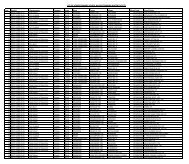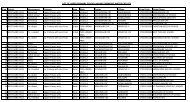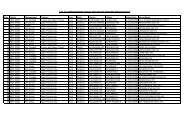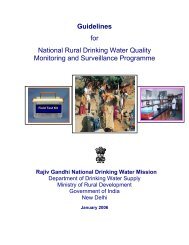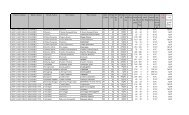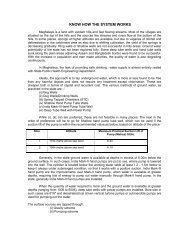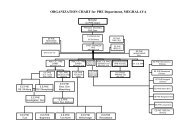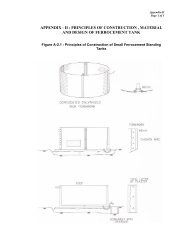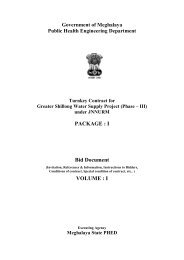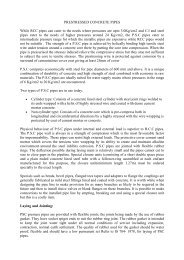PACKAGE : I Bid Document VOLUME : II - Public Health Engineering
PACKAGE : I Bid Document VOLUME : II - Public Health Engineering
PACKAGE : I Bid Document VOLUME : II - Public Health Engineering
You also want an ePaper? Increase the reach of your titles
YUMPU automatically turns print PDFs into web optimized ePapers that Google loves.
Expansion joints : For all pipe lines laid above ground, provision for expansion and<br />
contraction on account of temperature variation should be made either by providing<br />
expansion joints at predetermined intervals or by providing loops where leakage<br />
through expansion joints cannot be permitted. Where expansion joints are provided, it<br />
is necessary to create restraining points on the pipe line to ensure proper functioning<br />
of these joints. The pipe laying work should preferably start from the restrained points<br />
on either side working towards center where the expansion joint should be fitted last.<br />
Spacing of expansion joint depends on local conditions. Provision of expansion joint<br />
at intervals of 300m on exposed steel pipe line is to be provided. Expansion joints<br />
should always be provided between two fixed supports or anchorages.<br />
Anchorages : The pipe shall be anchored by concrete anchor blocks or other means to<br />
resist unbalanced water pressures and temperature stresses. Provision should be made<br />
to anchor the main during construction and in service where floatation could occur.<br />
18.8 Road and river crossing.<br />
The mode of laying the pipe line crossing road or a river shall be determined so as<br />
to satisfy the requirements of the department.<br />
18.9 Branch connections, specials, etc.<br />
Complicated specials, such as ‘Y’ pieces, composite bends and tapers, shall be<br />
fabricated in workshop. Small branches, single piece bends, etc, may be fabricated<br />
at site, care being taken to ensure that the fabricated fittings have at least the same<br />
strength as the pipe line to which these are to be joined.<br />
Appurtenance : The spacing of the isolating sluice valves along a pipe line depends<br />
upon the type of terrain through which the pipe line passes and the operational<br />
flexibility required. Valves may be positioned as follows:<br />
At the beginning and at the end of pipe line;<br />
To facilitate hydraulic testing of sections or the pipe line;<br />
For long pipe lines, isolating valves should be provided at intervals not exceeding<br />
6km; and<br />
On either side of a major crossing.<br />
Valves may be located either above ground or below ground, but should be easily<br />
accessible.<br />
1. Control valves should be provided on all branches. Similarly, air valves at all humps<br />
and scour valves at all dips are necessary. For inspection purposes, man-holes may be<br />
provided on either side of isolating valve and at other suitable places.<br />
DTS : Detailed Tender Specification. Page 174



